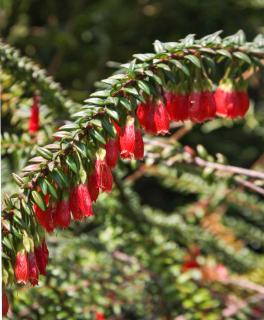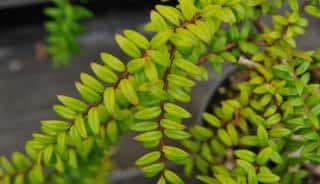

Also going by the name “Himalayan lantern”, Agapetes bears red bell-shaped flowers on long, swaying stems.
Key Agapetes facts
Name – Agapetes serpens
Family – Ericaceae
Type – Shrub
Height – 3 to 4 feet (1 to 1.50 m)
Exposure – part sun, shade
Soil – rich heath soil
Foliage – evergreen
Flowering – spring
Discover how to grow this cute little shrub.
Agapetes is a not-so-hardy plant that grows well in coastal areas. It requires rich and acidic soil, much like forest underbrush. A great idea is to compensate this by using soil mix made from leaves, it’s the ideal substrate for this plant.
As is the case for many frost-vulnerable plants, planting should take place in spring, after any risk of freezing has disappeard.
Growing Agapetes in a pot is a difficult project. Usually, potted specimens only survive for a few years, but it’s still worth trying! Best is to use heath soil with, again, dead leaves mixed in. Remember to layer the bottom of the pot with clay marbles for drainage. Agapetes is a plant that loves moisture and mild temperatures. A North-facing courtyard, sheltered from wind, is perfect to settle your potted plant into.
Preparing Agapetes cuttings is best in summer, around July-August. Cut 4-inch sections of stems. Remove leaves from the bottom half of the cutting. Plant the stems in a mix of heath soil and sand 50/50. Store your cuttings where it won’t freeze and not in direct sun. Wait until the next spring. Water often in order to keep the substrate moist. As early as April-May (depending on where you live), transfer to a pot or the ground.
Your main goal should be to make sure the soil stays cool for your Agapetes. You’ll thus have to water during drought, and add fresh mulch every spring to lock moisture in.

This will trigger branching out of fresh new stems, making the whole shrub look more lush and dense.

The substrate must remain cool, without getting soggy. During times of drought, a great option is to use an olla. This slowly releases water to the soil around it.
Agapetes isn’t a very common plant in our areas because of the inhospitable climate. However, for coastal gardens, it’s a plant that will definitely stand out! Long, flexible stems arch out and are dotted with small, dark green oval leaves. At the end of each stem, tiny bellflowers appear. Aligned at the end of the stem, these flowers come in tones of red, pink or cream depending on the variety.